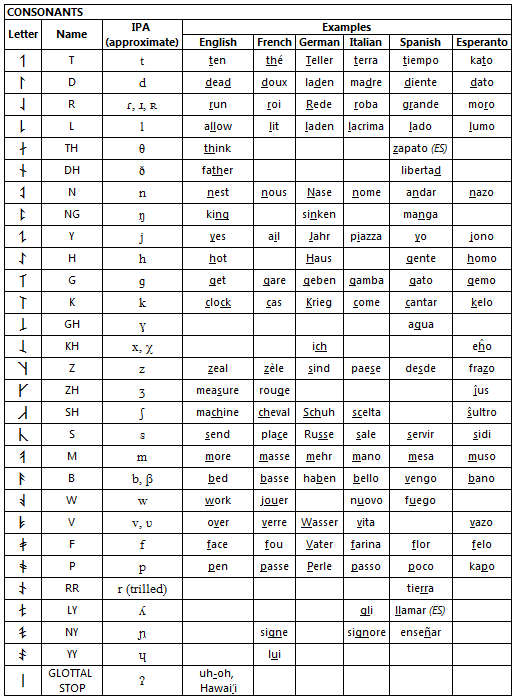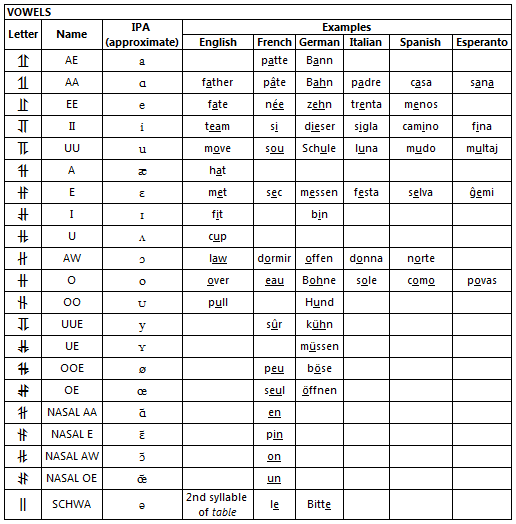
The Ewellic Alphabet: What Are Those Strange Symbols, Anyway?

 |
The Ewellic Alphabet: What Are Those Strange Symbols, Anyway? |
 |
 |
 |
The three symbols in the upper-left corner of this page are actually letters. They’re not Chinese or Wiccan. They’re Ewellic.
Ewellic is a phonetic alphabet I invented back in 1980, when I was in high school. Originally unnamed, it was intended as a form of secret writing—I kept diaries in it and such—but because it was phonetic, I also found it useful for showing the pronunciation of words and names with unusual English spellings. (Or maybe that was just a flimsy excuse to use it.) When I started college I lost interest in my alphabet and stopped using it.
More than a decade later, I discovered Unicode and started learning about the different, exotic writing systems that Unicode would one day support, just as soon as some real-world Unicode systems started to appear. I found that my phonetic alphabet had many characteristics in common with “real” scripts, even though I had no formal training in linguistics or writing systems at the time I created it (nor now, for that matter).
By 1997 or thereabouts, I had found the ConScript Unicode Registry (CSUR), maintained by John Cowan and Michael Everson, which unofficially allocates space in the Unicode Private Use Area to various “constructed” scripts, including several invented for works of fiction. This renewed my interest in my own alphabet, which in an uncharacteristic fit of vanity I named “Ewellic” (the name was inspired by Cyrillic, the Slavic script developed by the followers of St. Cyril and better known among Westerners as the “Russian alphabet”). It’s pronounced /juˈwelɪk/ for those who can read IPA and have a suitable font, or yoo-WELL-ik for those who can’t or don’t.
In October 2000 I submitted a proposal to register Ewellic in CSUR. The proposal was posted in March 2002, and was revised four times:
Ewellic was registered in CSUR in February 2008. The block now starts at U+E680, to include the new letters.
Strictly speaking, Ewellic is phonemic rather than phonetic. That means it does not distinguish between non-essential differences in phonemes, the basic sounds that make up a spoken language. For example, there is only one letter for the O sound in the word show, even though British and American speakers might pronounce that O quite differently.
Since it was invented by a 17-year-old enthusiast rather than a trained linguist, it has its inconsistencies and imperfections, and one of the world’s most respected scholars of writing systems has dismissed it as “not practical.” Oh well, I like it.
Six sample texts are now available:
You must have James Kass’s Code2001 or Code2000 font in order to view these pages. Note that some words are broken across lines on Microsoft Internet Explorer, and perhaps other browsers as well. This is unavoidable because of the way IE handles line breaking for Private Use characters.
For true Unicode weenies, a list of Unicode character properties is now available as well.
The charts on the right side of this page show the relationship between Ewellic letters and sounds. A complete list of letters is available, along with a page of additional charts that shows the letters, digits, and ligatures. (Digits? Did I forget to mention digits again? Ewellic is the only script I know that directly supports hexadecimal numbers.)
Use these handy references as you make your way through the sample texts, and feel free to contact me if you have any questions or comments. Before you know it, you’ll be well on your way to learning the Ewellic alphabet.
By the way, the three Ewellic letters at the top of this page, and all of my pages, spell “Doug.” (Three sounds, three letters.) Clicking on them will always return you to my home page.
| Copyright © 2002–2013 by Doug Ewell • Last modified 2019-08-03 |
|
|
|